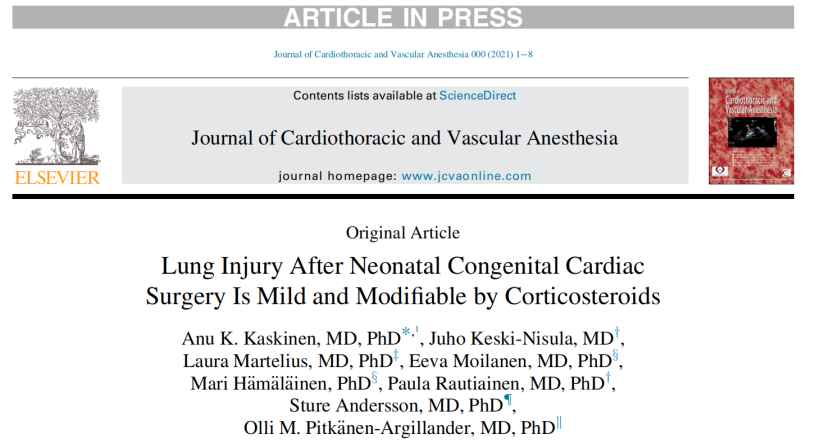Glucocorticoids can reduce lung damage after neonatal congenital heart surgery
- Normal Liver Cells Found to Promote Cancer Metastasis to the Liver
- Nearly 80% Complete Remission: Breakthrough in ADC Anti-Tumor Treatment
- Vaccination Against Common Diseases May Prevent Dementia!
- New Alzheimer’s Disease (AD) Diagnosis and Staging Criteria
- Breakthrough in Alzheimer’s Disease: New Nasal Spray Halts Cognitive Decline by Targeting Toxic Protein
- Can the Tap Water at the Paris Olympics be Drunk Directly?
Glucocorticoids can reduce lung damage after neonatal congenital heart surgery
Glucocorticoids can reduce lung damage after mild neonatal congenital heart surgery A supplementary report of a randomized, double-blind, placebo-controlled clinical trial. Glucocorticoids can reduce lung damage after mild neonatal congenital heart surgery.
This study aims to investigate whether the lung injury after neonatal congenital heart disease surgery is manifested as pulmonary edema, and whether the stress-dose glucocorticoid (SDC) regimen can reduce the lung injury after neonatal congenital heart disease surgery.
A supplementary report of a randomized, double-blind, placebo-controlled clinical trial.
40 newborns (age ≤ 28 days) underwent congenital heart surgery under cardiopulmonary bypass.
After induction of anesthesia, the children were randomly assigned to receive intravenous methylprednisolone 2 mg/kg or placebo b. After weaning 6 hours, they were given hydrocortisone or placebo injections. The course of glucocorticoid treatment was 5 days. The specifics are as follows: the first 48h treatment dose is 0.2 mg/kg/h, the second 48h treatment dose is 0.1 mg/kg/h, and finally 0.05 mg/kg/h is continuously treated for 24h.
Measurements and main results:
The pulmonary edema scores of SDC patients on the first day (POD1), the second (POD2), and the third day (POD3) after surgery were lower than those of the placebo group (p=0.03); in addition, the pulmonary edema score of the placebo group increased slightly , Was 0.9, and the pulmonary edema score of the SDC group was maintained at the preoperative level. The postoperative compliance of the dynamic respiratory system in the SDC group was higher than that in the control group (P<0.01), lasting until POD3; however, postoperative oxygenation, mechanical ventilation time, and tracheal aspirate biomarkers of inflammation and oxidative stress, namely leukocyte mediator There were no differences between the two groups of hormone-6, interleukin-8, resistin and 8-isoprostaglandin.
Conclusion:
The SDC regimen reduced the development of mild imaging pulmonary edema of unknown clinical significance, improved postoperative dynamic respiratory system compliance, and no adverse reactions, but failed to improve postoperative oxygenation and mechanical ventilation duration.

Lung Injury After Neonatal Congenital Cardiac Surgery Is Mild and Modifiable by Corticosteroids
Abstract
Objectives: The present study was performed to determine whether lung injury manifests as lung edema in neonates after congenital cardiac surgery and whether a stress-dose corticosteroid (SDC) regimen attenuates postoperative lung injury in neonates after congenital cardiac surgery.
Design: A supplementary report of a randomized, double-blinded, placebo-controlled clinical trial.
Setting: A pediatric tertiary university hospital.
Participants: Forty neonates (age ≤28 days) undergoing congenital cardiac surgery with cardiopulmonary bypass.
Interventions: After anesthesia induction, patients were assigned randomly to receive intravenously either 2 mg/kg methylprednisolone or placebo b, which was followed by hydrocortisone or placebo bolus six hours after weaning from CPB for five days as follows: 0.2 mg/kg/h for 48 hours, 0.1 mg/kg/h for the next 48 hours, and 0.05 mg/kg/h for the following 24 hours.
Measurements and main results: The chest radiography lung edema score was lower in the SDC than in the placebo group on the first postoperative day (POD one) (p = 0.03) and on PODs two and three (p = 0.03). Furthermore, a modest increase in the edema score of 0.9 was noted in the placebo group, whereas the edema score remained at the preoperative level in the SDC group. Postoperative dynamic respiratory system compliance was higher in the SDC group until POD three (p <0.01). However , postoperative oxygenation; length of mechanical ventilation; and tracheal aspirate biomarkers of inflammation and oxidative stress, namely interleukin-6, interleukin-8, resistin, and 8-isoprostane, showed no differences between the groups.
Conclusions: The SDC regimen reduced the development of mild and likely clinically insignificant radiographic lung edema and improved postoperative dynamic respiratory system compliance without adverse events, but it failed to improve postoperative oxygenation and length of mechanical ventilation.
(source:internet, reference only)
Disclaimer of medicaltrend.org



